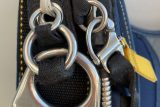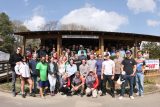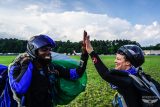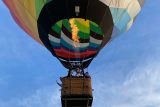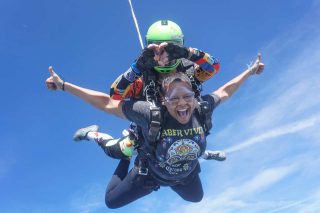30 Years of Skydive Carolina: Danny Smith’s Story
Dropzone News
9 years ago
Celebrating 30 Years in Business
Danny Smith is a proud member of a rarefied group; he’s one of the only people on the planet who has been an active skydiver for half a century. This year, as he celebrates his 50th year in the air, the dropzone he founded–the world-famous Skydive Carolina–celebrates a birthday of its own, with thirty candles in the cake.
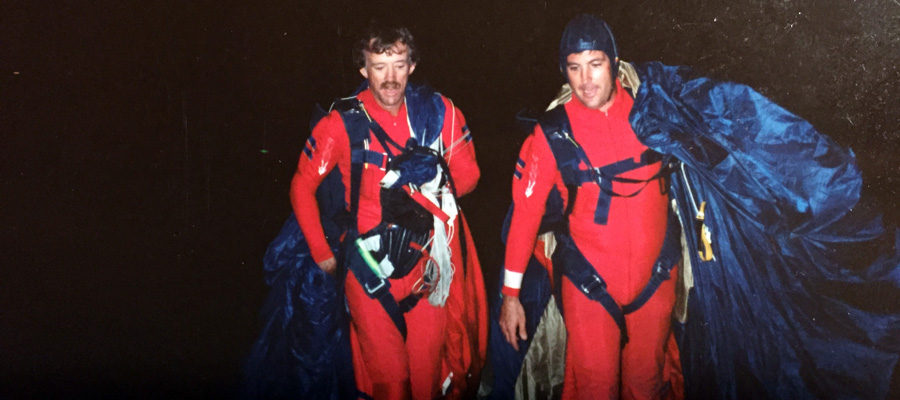
Pictured Above: Danny Smith and Skip Summers after a night demo jump at Clemson’s Tigerama in 1991. The pair landed in front of 40,000 people.
When Danny started skydiving, he was in the Air Force. Since he was an avid athlete in high school, it’s no surprise that a Golden Knights demo jump into an airbase event put stars in the young NCO’s eyes. After a little sniffing around, he discovered a closeby skydiving club: the Ark-LA-Tex Skydivers, near Shreveport. In 1966, he made his first jump. It was everything he thought it would be. He was hooked.
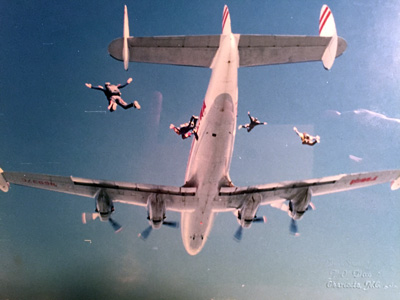
Photo Left: Danny Smith (jumper on far left) exits a Boeing Constellation, “Connie” during the 1996 World Free Fall Convention in Quincy, Illinois.
That first dropzone in Shreveport was on public land; the landing area was an enormous field banded by a grass strip runway, and there was nothing else on the property. This was the club’s second location; they had previously been based at a more upscale location with a paved tarmac in Mansfield, Louisiana. They didn’t have a plane either, so one of the club members who worked for an aviation company sorted them out. He would rent a Cessna airplane, bring it to the grass strip, take the door off and the seat out, and open manifest. Finally, after scraping by for a while, one of the members organized a Stinson Gullwing V77 for the club.
“It was really a cool airplane to jump,” Smith remembers, “but it had the smallest door, and it was hard to get out of with the big military-surplus gear we used in those days. Ours was painted bright red with the club logo on the side. We were a pretty cool club.”
Danny’s appetite for skydiving was ravenous by the time he matriculated from the active duty Air Force and moved back to his North Carolina home. “I had a whopping 12 jumps when I got back to Asheville,” Smith laughs, “so the first question I asked when I went on to college was where I could skydive.” As it turned out, there was nothing in the Asheville area; the closest dropzone was the Charlotte Skydivers Club and that’s where Danny ended up jumping for many years.
College led the young Danny directly into corporate America. He pressed a suit, tugged on a necktie, and strode into a long-lived professional career as a banker for First Union National Bank. The suit, of course, disappeared on Friday afternoons, and the buttoned-up young banker headed out for flurries of weekend skydives. He managed to rearrange his work schedule so he could join the club for Tuesday afternoon jumps which became a sacred tradition.
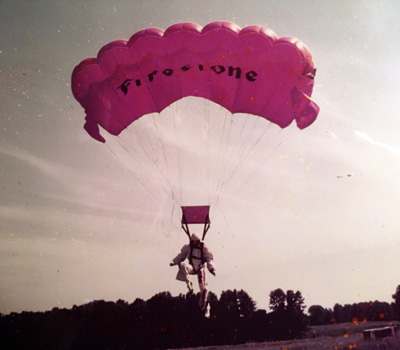
Above: Practicing accuracy landing at the Charlotte Skydivers Club in 1980.
In 1975, Danny’s skydiving took on an additional dimension: performing. That spring, an Ohio gentleman by the name of Paul McCowan approached Danny at the dropzone with a proposal. The company he worked for owned three regional amusement parks: Kings Dominion, Kings Island and Charlotte’s own Carowinds. They were looking to run air shows on a regular basis which would be sponsored by Firestone Tire and Rubber. McCowan had been tapped to continue the skydiving element of the program at Carowinds and was look for skydivers. Someone had suggested that McCowan talk to Danny and Danny leapt at the opportunity. From 1975 to 1981, Danny served as the captain of that Carowinds team, every single weekend.
The team was comprised of three members – just the right staffing to squeeze into a Cessna 182 which, by that time, Danny happened to own. The trio did a lot of shows outside of the park; they advertised for Firestone and Carowinds with their canopy showmanship at places like the Charlotte Motor Speedway, Wilmington’s annual Azalea Festival and lots of fairs.
For Danny, the most memorable of these demos was the day they jumped the battleship.
The idea popped up after a demo when the team landed in the grass right next to the docked USS North Carolina. As they were bundling up their gear, the Firestone rep that was in the audience sidled up to Danny.
He asked Danny, “Hey, do you think you can land on an aircraft carrier?”, and Danny replied, “I don’t see why not.” Danny says he’s glad he took the challenge as that demo is still “the most memorable jump” he’s ever made.
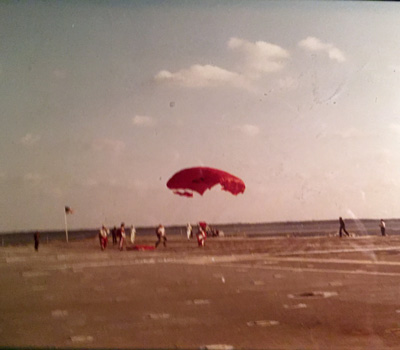
Left: June 16, 1978. Landing on the USS Yorktown.
The team traveled to Charleston to do a technical requisition of the proposed jump from high over the water, down to the deck of the venerable USS Yorktown.
“I was standing in the middle of that ship,” Danny smiles, “and I was saying heck yeah. It was 900 feet long and 120 feet wide–of course, we could do it. The day we did it, we were up at 6,000 feet, and the ship looked like a little canoe sitting there in the water. When we had first looked at it, the wind had been blowing north and south, so we had 900 feet to work with. But that day, of course, the wind decided to blow to the west, which means we had 120 feet to work with. Really, we had 60 feet if we wanted to land dead center. As we were about to jump, the winds were borderline–but how many opportunities do you get to jump on an aircraft carrier? So we did it, and we pulled it off.”
“There was a rumor going around,” he continues, laughing, “that the Navy guys were mad at us because we were the first civilians to ever jump on a Navy ship.”
As Danny’s jumping was heating up, the Charlotte Skydivers Club was winding down. People were slowly dropping out of the club, and there weren’t many left. One night at a club meeting, Danny spoke up. “We have got to do something,” he said. Danny suggested that it was time to open a commercial parachute center. The club members said ‘you’re it’. “At the time I was still working at First Union, but I knew I had to find a way, or I wasn’t going to keep jumping.”
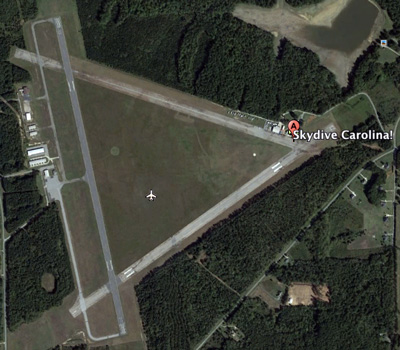
Danny’s initial research brought him to an old military base in Chester, South Carolina. The airport was huge – three 5,000-foot runways in a tidy triangle with an interior space of six hundred acres. “Even today,” Danny adds, “it’s one of the biggest landing areas of any skydiving center in the country. We are spoiled, to be honest with you.”
When Danny first saw it, the only thing on the Chester airfield was an old glider operation. He and the club approached the airport commission which gave the green light for skydiving. Danny borrowed a Cessna 182, three parachutes and three radios from one of his mentors, the late, great Roger Nelson. “We still have that 182, which Roger eventually sold to me,” Danny says. “That will be the last thing we ever sell.”
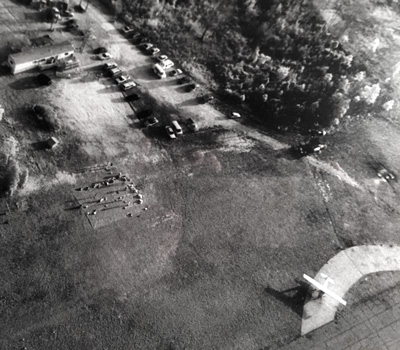
Above: The DZ used to be located on the southeast side of the field. This photo taken in 1988. Packing used to take place on the tarp.
“We opened the doors in July 1986, part-time, just weekends only,” Danny muses. “That first year we were in operation, we had a grand total of 99 student jumps, and 1,217 jumps total. Now we are pushing over 4,500 student jumps a year, and anywhere from 28,000 to 32,000 total jumps a year.”
In 1988, the nascent dropzone was already adding a second 182 to the fleet, but Danny was still full-time at the bank, and he barely had a staff. He’d regularly leave the bank at 6pm in the afternoon and spend the rest of his hours at the airfield. “I was an officer in the bank, so I had managers working for me,” he explains, “I was able to spend some time away whenever I needed to, and I had a good boss who knew what I did and supported me in that respect.” He’d often work into the night, doing the rigging, packing the parachutes and seeing to the aircraft.
It was around this time that the late, great Gene Paul Thacker, one of Danny’s mentors, had some advice for his hardworking mentee. “He said, ‘Danny, if you needed one Cessna 182, you need two, because you need a backup,’ ” Danny says, “but of course we didn’t have a lot of money in the bank account back then, so we had to wait a little while to be able to put that second one on.”
Once both planes were turning, demand came running to meet the supply. Soon, both airplanes were going on both Saturdays and Sundays, which did much to improve the aforementioned bank account.
“What I started doing then,” Danny says, “is periodically, through the year, I would bring a twin in. Sometimes it was Gene Paul Thacker’s, and sometimes it was a twin-engine airplane, for events.”
Predictably, that zippy twin-engine got very popular. Around 1992, Paul Fayard, another of Danny’s mentors, approached Smith about leasing a King Air from him. It took some doing, but having a 14-seater aircraft did much to build Skydive Carolina’s customer base and student program. By 1994, Smith was ready to walk away from banking for good and go full-time into dropzone operation, and he arranged to trade that King Air for one of Paul’s Twin Otters.
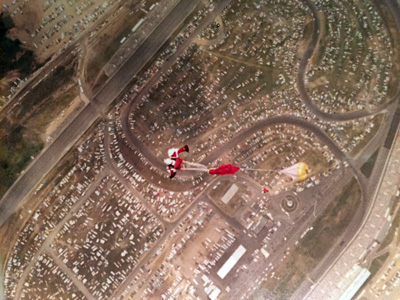
Left: 1980. Danny Smith jumping into the Charlotte Motor Speedway for what was then known as the NASCAR World 600.
“All through my banking career,” he muses, “I had a lot of good employees that worked for me, and great managers. I miss that, but as far as corporate America, I don’t miss it at all. I traded in my three-piece suit and tie for a pair of shorts and a t-shirt.”
The fleet kept growing, and the planes kept improving. Paul helped Danny buy his first King Air; soon after, the dropzone purchased a Caravan. These days, the dropzone operates a King Air, a Twin Otter, and a Cessna 182.
What had started as a single, multi-purpose building, grew as well. When the old glider operation moved away to open up its own private field, Skydive Carolina took over their hangar.
“We have two hangars now,” Danny points out. “We also have a training center, an office building, a bunkhouse and a snack bar. My wife and partner, Annette, who is an interior designer, has really made the place look great. Every year that we have been in business, we have continually grown and gotten bigger. I believe it is going to continue that way. Our numbers keep getting better.”
Then, of course, there’s CarolinaFest.
Nearly every skydiver on the planet knows about CarolinaFest. It’s one of the sport’s most famous boogies; driven to the top of the heap by word-of-mouth that trumpets the boogie’s top-shelf quality, spot-on organization and week-of-a-lifetime fun.
In 2009, James La Barrie, Skydive Carolina’s General Manager, brought Danny an idea: Let’s host boogies like the rest of the world’s destination drop zones. It was the perfect suggestion at the perfect time, and the results were epic.
“I mean, it is unreal,” Danny grins. “When we got started with it, we didn’t know what to expect, but CarolinaFest 2017 will be our 9th. We sell out every year because we have a hard-and-fast quota–always prioritizing quality over quantity. That’s the philosophy. We hire the best load organizers in the country. We have plenty of aircraft support. It is a hard work on the staff, but we get so pumped up to do it.”
Hard work, you ask? Yes. CarolinaFest 2016 saw 6,279 skydives in four and a half days.
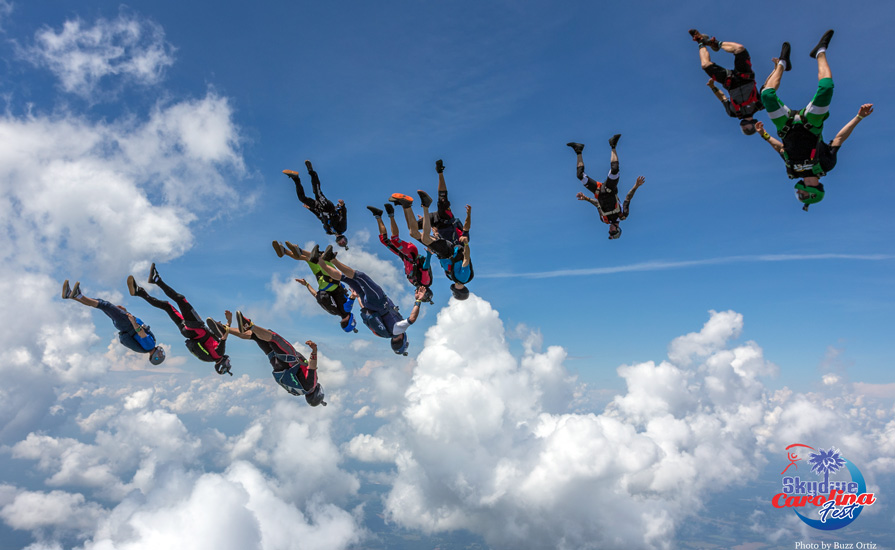
“Because I’ve been in it so long,” he continues, “I have a tremendous staff that I’m very proud of. I have a general manager that’s just knocking it out of the park for me, and he is allowing me to not do so much day-to-day even though I am here because I just can’t walk away from it. That said, I have to celebrate my 50-year anniversary, you know. My wife and I are going to do a little bit of traveling, and I am going to play a lot more golf, and let the stellar team we have here to continue to grow the business.”
“We always tell people, when they compliment our drop zone, thanks, but it’s always going to be a work in progress,” Smith says. “We have already got a number of improvements that we’re going to do over the winter season to get ready for 2017. It has been a long journey and a long up-and-down story, no pun intended, which I think every skydiving center goes through.”
“I still get energetic about it,” he concludes, eyes twinkling, “and I am still going. I just flat out enjoy it. I just do.”
